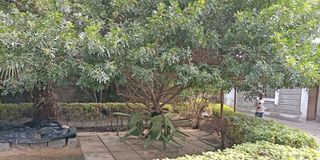Tree’s gum helps in curing dental ailments, H. pylori and renews skin

What you need to know:
- In the wild, it is a favourite for herbalists and there are concerns about overexploitation, especially around Nairobi.
- The gum, which is obtained by tapping the bark, also contributes to skin regeneration and wound healing.
- Algerian herbalists recommend use of Pistacia lentiscus leaves as an infusion to relieve sore throat, stomach pain and heartburn
- In Tanzania, the gum is chewed to strengthen gums and as a breath freshener, according to Edible Wild Plants of Tanzania by Ruffo, C.K. Birnie, A. & Tengnas, B. and Twigs are used as toothbrushes.
Pistacia lentiscus, also known as mastic tree, is native to Mediterranean and tropical African countries.
It grows well in ecological zones whose altitude ranges from 900 to 2,550 metres above sea level.
Among its local names in Kenya is Muheheti (Kikuyu). In Kenya, those who plant it do so mainly for environmental reasons – its thick, extensive and evergreen canopy provides an excellent shade as well as noise and dust control.
In the wild, it is a favourite for herbalists and there are concerns about overexploitation, especially around Nairobi.
Globally, this is also one of the most valuable trees. Two of its products – oil from its seeds and gum or resin from its bark – have high commercial value. In the world, the Greek island of Chios produces the best quality while in Africa, Somalia and Algeria are top producers.
The gum is used in the food, health and cosmetics sector.
In July last year, New York Times columnist Frank Bruni wrote about the ability of medicine from Chios gum to help treat many ailments in a column titled ‘Can this Ancient Greek medicine cure humanity?’
Bruni suffers from a rare condition called naion, which has damaged the optic nerve behind his right eye. He is involved in a clinical trial in the US to determine if the fluid extracted from mastic gum could repair ravaged nerves.
An Israeli biotech start-up company, Regenera Pharma, produces the medicine. “Any positive results gained from this trial,” Bruni wrote, “Could also have profound implications for millions of Alzheimer’s patients and stroke survivors, who could also possibly benefit from the compounds in mastic.”
The gum, which is obtained by tapping the bark, also contributes to skin regeneration and wound healing.
Natural antioxidant
Additionally, it has antimicrobial and anti-inflammatory effects and comprises a natural antioxidant. It acts against common disorders of the digestive system.
A study in Algeria on the medicinal use of Pistacia lentiscus oil established that it is not only sold in herbalists’ shops, but also in many conventional pharmacies.
Algerian herbalists recommend use of Pistacia lentiscus leaves as an infusion to relieve sore throat, stomach pain and heartburn.
A 2010 study published in the Journal of Ethnopharmacology established that mastic gum has activity against Helicobacter pylori (H. pylori) , a hard-to-treat bacteria considered the predominant cause for gastric ulcers.
A 2017 study in the Journal for Periodontology found that mastic gum extract is effective in killing oral pathogens. It was also found to be less harmful to cells and tissues of the mouth than other antiseptic agents.
In Tanzania, the gum is chewed to strengthen gums and as a breath freshener, according to Edible Wild Plants of Tanzania by Ruffo, C.K. Birnie, A. & Tengnas, B. and Twigs are used as toothbrushes.
Mibelle Biochemistry, a Swiss company that specialises in mastic products, says the gum also has anti-diabetic, anti-hypertensive and anti-cancer activity. In the Mediterranean, mastic gum is blended in flour, cereal, pasta, tomato sauce, eggplant sauce, olive oil, salt and jams.
Threats
The tree is frequently injured from the gum tapping process. In Kenya, trees around Nairobi are threatened with extinction because of overexploitation by herbalists and the species is also thought to be extinct in Eritrea.
It is classified as 'near threatened' in the International Union of Conservation of Nature Red List of Threatened Species (1998).
Propagation
Pistacia lentiscus is propagated mainly through seeds. For faster germination, the seeds should be soaked for 16 hours in alkalised water, or for three to four days in warm water.
A number of private tree nurseries around Nairobi have seedlings, which sell for an average of Sh100 each.




